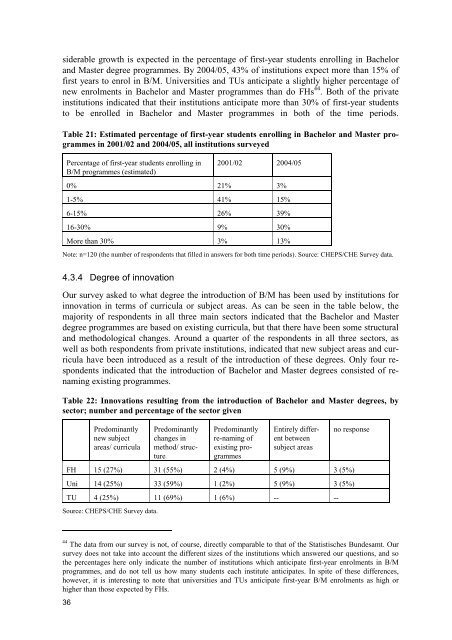and Master Programmes in German Higher Education Institutions
and Master Programmes in German Higher Education Institutions
and Master Programmes in German Higher Education Institutions
- No tags were found...
You also want an ePaper? Increase the reach of your titles
YUMPU automatically turns print PDFs into web optimized ePapers that Google loves.
siderable growth is expected <strong>in</strong> the percentage of first-year students enroll<strong>in</strong>g <strong>in</strong> Bachelor<strong>and</strong> <strong>Master</strong> degree programmes. By 2004/05, 43% of <strong>in</strong>stitutions expect more than 15% offirst years to enrol <strong>in</strong> B/M. Universities <strong>and</strong> TUs anticipate a slightly higher percentage ofnew enrolments <strong>in</strong> Bachelor <strong>and</strong> <strong>Master</strong> programmes than do FHs 44 . Both of the private<strong>in</strong>stitutions <strong>in</strong>dicated that their <strong>in</strong>stitutions anticipate more than 30% of first-year studentsto be enrolled <strong>in</strong> Bachelor <strong>and</strong> <strong>Master</strong> programmes <strong>in</strong> both of the time periods.Table 21: Estimated percentage of first-year students enroll<strong>in</strong>g <strong>in</strong> Bachelor <strong>and</strong> <strong>Master</strong> programmes<strong>in</strong> 2001/02 <strong>and</strong> 2004/05, all <strong>in</strong>stitutions surveyedPercentage of first-year students enroll<strong>in</strong>g <strong>in</strong>B/M programmes (estimated)2001/02 2004/050% 21% 3%1-5% 41% 15%6-15% 26% 39%16-30% 9% 30%More than 30% 3% 13%Note: n=120 (the number of respondents that filled <strong>in</strong> answers for both time periods). Source: CHEPS/CHE Survey data.4.3.4 Degree of <strong>in</strong>novationOur survey asked to what degree the <strong>in</strong>troduction of B/M has been used by <strong>in</strong>stitutions for<strong>in</strong>novation <strong>in</strong> terms of curricula or subject areas. As can be seen <strong>in</strong> the table below, themajority of respondents <strong>in</strong> all three ma<strong>in</strong> sectors <strong>in</strong>dicated that the Bachelor <strong>and</strong> <strong>Master</strong>degree programmes are based on exist<strong>in</strong>g curricula, but that there have been some structural<strong>and</strong> methodological changes. Around a quarter of the respondents <strong>in</strong> all three sectors, aswell as both respondents from private <strong>in</strong>stitutions, <strong>in</strong>dicated that new subject areas <strong>and</strong> curriculahave been <strong>in</strong>troduced as a result of the <strong>in</strong>troduction of these degrees. Only four respondents<strong>in</strong>dicated that the <strong>in</strong>troduction of Bachelor <strong>and</strong> <strong>Master</strong> degrees consisted of renam<strong>in</strong>gexist<strong>in</strong>g programmes.Table 22: Innovations result<strong>in</strong>g from the <strong>in</strong>troduction of Bachelor <strong>and</strong> <strong>Master</strong> degrees, bysector; number <strong>and</strong> percentage of the sector givenPredom<strong>in</strong>antlynew subjectareas/ curriculaPredom<strong>in</strong>antlychanges <strong>in</strong>method/ structurePredom<strong>in</strong>antlyre-nam<strong>in</strong>g ofexist<strong>in</strong>g programmesEntirely differentbetweensubject areasno responseFH 15 (27%) 31 (55%) 2 (4%) 5 (9%) 3 (5%)Uni 14 (25%) 33 (59%) 1 (2%) 5 (9%) 3 (5%)TU 4 (25%) 11 (69%) 1 (6%) -- --Source: CHEPS/CHE Survey data.44 The data from our survey is not, of course, directly comparable to that of the Statistisches Bundesamt. Oursurvey does not take <strong>in</strong>to account the different sizes of the <strong>in</strong>stitutions which answered our questions, <strong>and</strong> sothe percentages here only <strong>in</strong>dicate the number of <strong>in</strong>stitutions which anticipate first-year enrolments <strong>in</strong> B/Mprogrammes, <strong>and</strong> do not tell us how many students each <strong>in</strong>stitute anticipates. In spite of these differences,however, it is <strong>in</strong>terest<strong>in</strong>g to note that universities <strong>and</strong> TUs anticipate first-year B/M enrolments as high orhigher than those expected by FHs.36
















